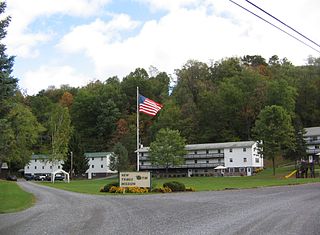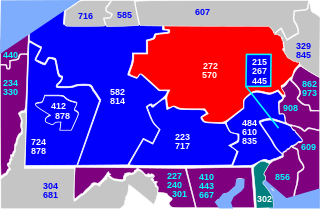
Montour County is a county in the Commonwealth of Pennsylvania. It is located in Northeastern Pennsylvania. As of the 2020 census, the population was 18,136. Its county seat is Danville. The county is named for Andrew Montour, a prominent Métis interpreter who served with George Washington during the French and Indian War. It encompasses 132 sq mi, making it the smallest county by land area in the state.

Montour Falls is a village located in Schuyler County, New York, United States. The population was 2,714 at the time of the 2020 census. A waterfall at the end of West Main Street gives the village its name. The name "Montour" is derived from Queen Catharine Montour, a prominent Native American woman of Seneca Indian heritage who lived at the village site in the 18th century.

Montoursville is a borough in Lycoming County, Pennsylvania. The 2020 census reported its population as 4,745. It forms part of the Williamsport, Pennsylvania Metropolitan Statistical Area. The Williamsport Regional Airport is in Montoursville.

Piatt Township is a township in Lycoming County, Pennsylvania, United States. The population was 1,045 at the 2020 census. It is part of the Williamsport Metropolitan Statistical Area.

The West Branch Susquehanna River is one of the two principal branches, along with the North Branch, of the Susquehanna River in the Northeastern United States. The North Branch, which rises in upstate New York, is generally regarded as the extension of the main branch, with the shorter West Branch being its principal tributary.
George Croghan was an Irish-born fur trader in the Ohio Country of North America who became a key early figure in the region. In 1746 he was appointed to the Onondaga Council, the governing body of the Iroquois, and remained so until he was banished from the frontier in 1777 during the American Revolutionary War. Emigrating from Ireland to Pennsylvania in 1741, he had become an important trader by going to the villages of Indigenous Peoples, learning their languages and customs, and working on the frontier where previously mostly French had been trading. During and after King George's War of the 1740s, he helped negotiate new treaties and alliances for the British with Native Americans.
Catharine Montour, also known as Queen Catharine, was a prominent Iroquois leader living in Queanettquaga, a Seneca village of Sheaquaga, informally called Catharine's Town, in western New York. She has often been confused with Elizabeth "Madame" Montour, her aunt or grandmother who was a noted interpreter and adviser to the governor, and with "Queen Esther" Montour, usually described as her sister. Several places in western New York were later named in her honor, after most of the Iroquois had been forced to cede their lands and were driven out of the region.
Sayenqueraghta was the war chief of the eastern Seneca tribe in the mid-18th century. He was born the son of Cayenquaraghta, a prominent Seneca chief of the Turtle clan in western New York. He lived most of his life at Kanadaseaga, near the present day town of Geneva, New York. He obtained his rank of war chief in 1751. Before the American Revolution he was referred to as chief of the Senecas.

Area codes 570 and 272 are telephone area codes in the North American Numbering Plan (NANP) for the northeast quadrant of the U.S. state of Pennsylvania. The numbering plan area (NPA) includes the cities or towns of Scranton, Wilkes-Barre, Williamsport, Stroudsburg, East Stroudsburg, Pittston, Carbondale, Hazleton, Clarks Summit, Towanda, Bloomsburg, Sayre, Tunkhannock, Berwick, Milford, Montrose, Honesdale, Pocono Pines, Nanticoke, Tamaqua, Shavertown, Dallas, Mahanoy City, Sunbury, Jim Thorpe, and as far south as Pottsville and as far west as Lock Haven.

Loyalsock Creek is a 64-mile-long (103 km) tributary of the West Branch Susquehanna River located chiefly in Sullivan and Lycoming counties in Pennsylvania in the United States. As the crow flies, Lycoming County is about 130 miles (209 km) northwest of Philadelphia and 165 miles (266 km) east-northeast of Pittsburgh.
Andrew Montour, also known as Sattelihu, Eghnisara, and Henry, was an important mixed interpreter and negotiator in the Virginia and Pennsylvania backcountry in the latter half of the 18th century. He was of Oneida and Algonquin ancestry, with a French grandfather. Historian James Merrell estimated his birth year as 1720. Likely born in his mother's village of Otstonwakin, he later led the village in the 18th century before settling further west.
Catherine's Town was a Seneca village, named informally for a prominent Seneca woman, Catherine Montour. It was located at the south end of Seneca Lake, near present-day Watkins Glen in what is now Schuyler County, New York.

The West Branch Susquehanna Valley of central Pennsylvania, United States, in the Ridge-and-valley Appalachians, is the low-lying area draining into the West Branch Susquehanna River southeast of the Allegheny Front, northeast of the Bald Eagle Valley, southwest of the Wyoming Valley and north of the water gap formed between Shamokin Mountain and Montour Ridge.

This article details a history of Lycoming County, Pennsylvania.
Madame Montour was an interpreter, diplomat, and local leader of Algonquin and French Canadian ancestry. Although she was well known, her contemporaries usually referred to her only as "Madame" or "Mrs." Montour. She may have been Isabelle Couc, a mixed born in 1667, or perhaps Isabelle Couc's niece, who was born around 1685 and whose given name is uncertain.

Shikellamy, also spelled Shickellamy and also known as Swatana, was an Oneida chief and overseer for the Iroquois confederacy. In his position as chief and overseer, Shikellamy served as a supervisor for the Six Nations, overseeing the Shawnee and Lenape tribes in central Pennsylvania along the Susquehanna River and protecting the southern border of the Iroquois Confederacy. While his birth date is not known, his first recorded historical appearance was in Philadelphia in 1728. In 1728 he was living in a Shawnee village in Pennsylvania near modern Milton, and moved in 1742 to the village of Shamokin, modern day Sunbury, at the confluence of the West and North Branches of the Susquehanna. Shikellamy was an important figure in the early history of the Province of Pennsylvania and served as a go-between for the colonial government in Philadelphia and the Iroquois chiefs in Onondaga. He welcomed Conrad Weiser to Shamokin and served as Weiser's guide on his journeys into the frontier of Pennsylvania and New York.

The Big Runaway was a mass evacuation in June and July 1778 of white settlers from the frontier regions of North Central Pennsylvania during the American Revolutionary War. It was precipitated by a series of raids against local settlements on the northern and western branches of the Susquehanna River by Loyalist troops and British-allied Indians, which prompted Patriot militia commanderes to order the evacuation. Most of the settlers relocated to Fort Augusta near modern-day Sunbury, Pennsylvania at the confluence of the northern and western branches of the Susquehanna River, while their abandoned houses and farms were all burnt as part of a scorched earth policy.

Major Moses Van Campen (1757–1849) was a soldier during the American Revolutionary War. He was a prominent figure in Pennsylvania and parts of New York. His primary involvement in the Revolutionary War was in fighting against hostile Native American tribes. He began work as a soldier in 1775 and retired from military service in 1783. Van Campen was familiar with Native American methods of warfare. He also participated in the Sullivan Expedition in 1779.

North Mountain is a 2,584-foot (788 m) ridge primarily located in Davidson Township of Sullivan County in the U.S. state of Pennsylvania. Its summit is that county's highest point, the 10th highest among the state's 67 counties. Portions also extend into neighboring Lycoming, Luzerne, and Wyoming counties.

June Clayworth was an American stage and film actress.














